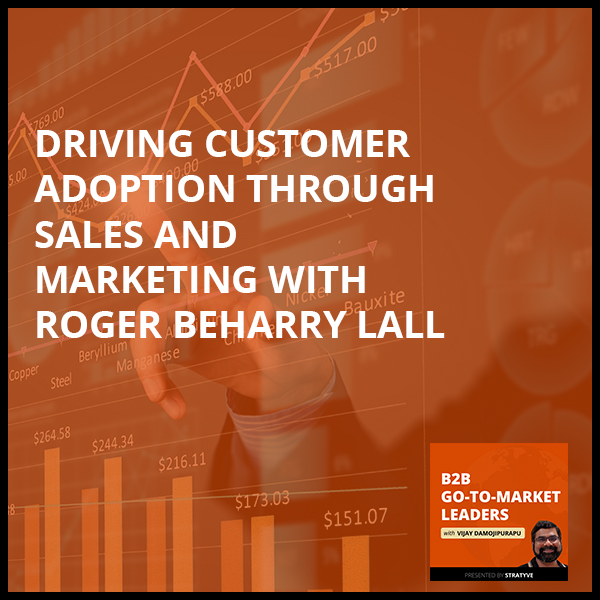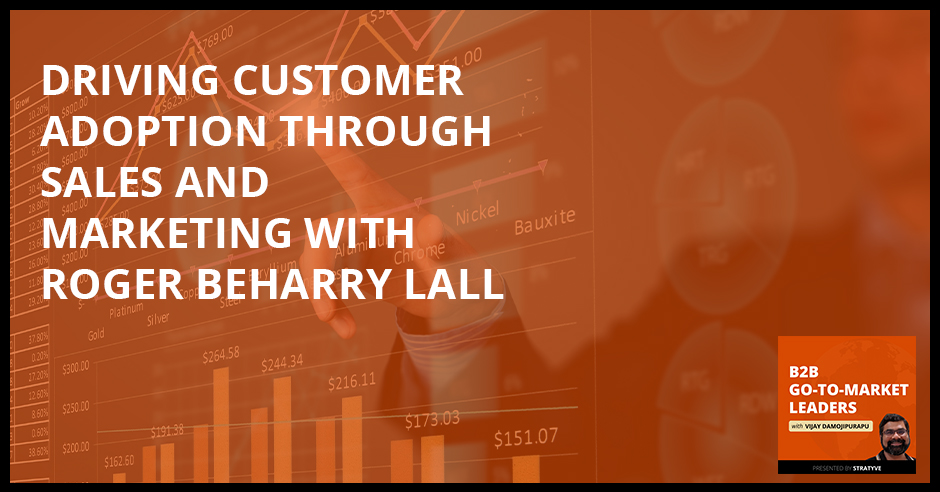

There is bigger machinery behind enabling sales. In a B2B SaaS world, it doesn’t stop at building your customer and the buyer. It starts after the fact, which is about customer success, user adoption, and then retention. That is why the go-to-market is vital for any company, and Vijay Damojipurapu has the guest to speak to us about taking this strategy to his company. He sits down with Roger Beharry Lall, the VP of Marketing at Traction Guest. Here, he talks about his go-to-market journey, how he is going beyond the product launch, and thinking of the product roadmap, scaling, and building a community. He shares how they are working on sales and marketing to drive customer adoption rather than treat them like oil and water. On his own career journey, Roger brings in his rich insights and global cultural experience from studying in Singapore, working in Korea, and big companies. Join in on this jam-packed episode to learn more.
—
Listen to the podcast here
Driving Customer Adoption Through Sales And Marketing With Roger Beharry Lall
I have the pleasure of hosting Roger from Traction Guest. Roger is the VP of Marketing at Traction Guest. Welcome to the show, Roger.
Thanks very much. It’s a pleasure to be here.
When I looked up your background, my intent is to bring up diverse, accomplished leaders in the whole go-to-market space. That’s my promise to my audience. When I looked up your profile, a few things caught my eyes. One is you’ve got a global cultural experience both from the studying days to even the working days. You studied in Singapore. You’ve worked in Korea. You worked for companies like TELUS and some leading brands in Canada. You worked for Research In Motion, BlackBerry. For those of you who have been around, you would know what we are talking about. Now, you’re at Traction Guest. I’m looking forward to teasing out all those nuggets and insights from your diverse experience.
I’m happy to share.
My first question to you and what you can share with our readers is, how do you define go-to-market?
To some extent, the argument is what isn’t a go-to-market? In my mind, especially coming from a product marketing background, it’s about everything you could think of. From a marketing and strategy perspective, that can be fed into the notion of go-to-market. For me, it’s a little bit old school. I almost go back to the proverbial 4 Ps, 5 Ps, 7 Ps of marketing. Originally it was Product, Price, Place and Positioning. There are a hundred variations around. I might be oversimplifying but that does speak to the notion of, what is go-to-market?
Go-to-market is something bigger than a product launch, but maybe smaller than a company strategy. It fits right in the middle. It’s Product, Place, Price, Promotion, Positioning, etc. It’s diving deep into each of those areas. If we think about a product, it’s not just the product you sell but, what are the partners that layer on to that? What are the services that add on? What’s the whole product? What’s the value proposition around that? Pricing strategy, that’s fairly self-explanatory. Place, I think of that not physically but channel-wise. Are we placing this directly? Do we go indirect? Do we have partnerships? Do we layer on top of them? Do they sell on our behalf? Do they take a cut?
The go-to-market is something bigger than a product launch but maybe smaller than a company strategy. Share on XFinally, I think about positioning. This is a core one for me coming from a product marketing background. How are we positioning? How are we going to go-to-market? How are we positioning ourselves there? There’s so much that goes into that. What is the audience? What is the vertical? What are the personas? What is our story? What value proper are we bringing to market? All that feeds into that final notion of positioning the ladders into what you might think of as a go-to-market. That’s probably oversimplifying it but there is some notion of the 4 Ps.
It probably starts early on in the cycle with a lot of research and analysis. It ends up in the middle with a lot of execution work, a lot of cooperative work with sales and marketing counterparts. Especially in the modern era, there is a lot of post-work to be done in terms of analyzing the success and failures, win-loss analysis, and things of that ilk. Getting the data to prove, correct, iterate, and then cycle back through that process.
Back in the days when I was fairly young and new in my go-to-market journey, especially when I was in my first product marketing role, that’s what I used to take, which is go-to-market is the launch. That’s a base notion. That’s how a lot of folks in marketing associate go-to-market with.
I’ve experienced this a few times where it’s not even the product launch. I’m not going to say that the product launch is easy, but that’s one element. It’s all the before, during and after. How do I control, nudge and manage the change within the organization? How do I temper expectations from sales? How do I provide enablement to sales if they’re at the right time to align to the right level of product readiness that might hit for the appropriate market awareness? It’s not as simple as, “We have this product and it’s ripe and it’s good to go.” You’re constantly turning these dials up and down and that is the challenge.
Continuing our discussion over here, it starts with a product launch. Over time, something that I’ve gained insight into and realization is it’s a lot more than just a product launch. It starts with that, but then there’s the whole notion of how are you thinking about your product roadmap? There’s a whole notion of how are you evolving and staying in touch with your customers and building a community? There’s a whole notion about that. There’s bigger machinery behind enabling sales. In a B2B SaaS world, it doesn’t stop at building your customer and the buyer. A bigger game starts after the fact, which is about customer success, user adoption, and then retention. If you do your job well, you will gain advocates for your company and products.
That is the hope. I’m planning our virtual customer advisory board meeting. We’ve got a dozen or so Fortune 500 class companies that we bring in. We used to bring in physically but now we’ll bring into a virtual call. That’s part of that iterative. Getting feedback and, are we on the right track? We’re looking at launching these things. How should we launch them? Where should we position? That feedback is invaluable.

That’s a key component, customer advisory board and community. Share with us your journey in how you grew. What are the milestones or transitions? What did you feel had took you to the next level in your whole go-to-market journey?
It’s funny as I think back on the career. I don’t know that product marketing or even go-to-market were coined terms back in the day. It was just good marketing. That was part and parcel. We knew there were B2B, B2C, and that was about it. I started my career as a subsidiary of IBM and TELUS, working in Korea of all places. It was field marketing and a little bit of channel marketing partnerships.
Was that your first job?
That was my first job out of university. It was advertised as a European software company. I had visions of working in Amsterdam or living in Paris. It was a software package called BON, which no longer exists. They were a competitor to SAP. We were deploying BON software in the Asian market. It was a European software deployed by a Canadian company in the Asian market. It’s incredibly a complicated or complex reality but fascinating. It’s a great learning experience. I started there, international exposure, and a little bit of consulting exposure. It gave me a good sense of the business process and re-engineering.
From that field of marketing, I came back to Toronto. I did a number of different roles. A general marketing manager would be what you would call it now. You might call it demand gen. You might call it event management. I did things of that ilk. I spent a good stint in Research In Motion, BlackBerry. It started to become more and more focused on what we call now product marketing. Back then, I looked at channels for a while. I looked at verticals or industry solutions for quite some time. I was instrumental in a small team that launched a Wi-Fi-only device, which sounds utterly trivial. At the time, putting Wi-Fi in a phone was completely unheard of. I got a sense of some of that product marketing and channel field type experience. I did a bit of secondment in RIM, which I love doing market research and industry analyst relations. It was a lovely opportunity to get some academic aside. It’s a little bit more strategic. It’s a little bit once removed to some extent. It’s a great opportunity and the thing that oftentimes can be hard to do unless you’re at a larger organization.
From there, I spent several years at Series-A style companies, scale-ups in a health tech, content marketing space, cannabis data analytics space. It’s a startup in that area. I’m at a company called Traction Guest that is focused on physical security, visitor management, and what we describe as a workforce security platform. A number of different areas, but all the time B2B enterprise moving from field marketing or marketing at large to a little bit more a vertical segment product marketing type role to more marketing leadership roles taking over ownership of the entire team. Combining that demand, field, channel, product marketing, and go-to-market all into one mindset, and increasingly having greater responsibility for managing the team more so than delivering the particular asset.
All of these experiences must have given you different perspectives and growth levers looking at it from the field marketing, the local markets outside of your core geography where the company may be based out of, that’s one. Also, looking at the sales piece because you’re looking at driving demand gen, which means you have to be collaborating closely with the sales teams and understanding the friction points as well as a healthy tension discussion between marketing and sales. That’s a constant battle, which I’m sure you can relate to and you have managed it all along. Talk to us about that. How do you manage that?
It's not that sales work for marketing or marketing work for sales. We’re all working to drive customer adoption. Share on X
It’s part and parcel. In sales and marketing, the joke is always that we’re like oil and water. The reality is that doesn’t have to be the case. At Traction Guest, I’m blessed. Culturally, we’ve done a good job of making sure that sales and marketing are well aligned, there’s good camaraderie, and there’s good support. Frankly, that’s how it should be. We’re all driving to the same goal. The key anchor point is to make sure that everybody is on the same page. We’re all trying to drive revenue. We have different levers that we might pull. Marketing, you can call it top of the funnel. It might be awareness. It might be sales material, content, and assets that enable the sales. It might be persona definition so we know who to target. Those are tools that feed into the sales cycle. They’re not detached. They’re not things that are academic, esoteric, or done in a vacuum for their own sake. It’s critical to be able to connect the dots and to constantly be reinforcing that story. We’re working together. It’s not that sales work for marketing or marketing work for sales. We’re all working to drive customer adoption.
Let’s talk about what you do at Traction Guest. You did touch upon that. What is your role at Traction Guest? What is your marketing team? How do you build your marketing team?
I started here at the midpoint of the pandemic. It’s a lovely time to join an organization. I was onboard and met some of the team. The team has been in a bit of a growth mode. We’ve had some people come and go over the last while and whatnot. I’ve been rebuilding the team a little bit. I’m the VP of Product Marketing by title. I’m also acting as Head of Marketing overall. It’s a dual role. I’m individually responsible for the product marketing deliverables, that mindset and thought process around personas and competitive analysis, and things of that ilk.
As an executive, I’m responsible for the marketing team at large. I think of it as almost three areas. There’s a content area, which is a content marketer, graphic designer, and web person. They’re building the materials and the assets. In the middle, you can think of it as demand gen group that is digital as well as events, different tools and different ways to get the message out to take that content and either use it as a magnet or pushing it out as nurture. The final group is more on the operation side. I’ve got a couple of folks that work on salesforce administration and marketing operations. They live somewhere between marketing, sales, finance, and connecting all the dots.
You talked about the evolution of careers. When I was starting in marketing, the budget spent for technology was in Excel sheet. That was about it. Maybe you had a CRM tool. Nowadays, you’ve got 20, 30 different tools in the MarTech stack. It can be easily a third or half of your budget, depending on the nature of the organization. Having folks to manage that becomes increasingly critical and part of a modern marketing capacity. We’ve got some content folks. I’ve got myself doing product marketing. We’ve got the demand group driving home with the customers. We’ve got the operations as tying it all together.
It’s a pretty well-rounded team.
I’m blessed. We’ve hit the point where we’ve got all the roles filled. We’re in a good place where we’re able to start delivering, executing, and moving much faster and driving much more growth, especially as we shift from SMB and increasing it into the enterprise towards account-based marketing. It’s a great team. I’m thrilled to be working with them and glad to be able to drive this growth for the company.

You briefly mentioned how you’re thinking about your marketing team and the structure. Traction Guest is a Series-A funded company. The executives and the board had their eyes on the next round of funding, Series-B and growth and scale targets. From what I’ve seen for Series-A, the marketing budget is roughly about 10%-ish of your overall revenue. Would you agree with that?
I will neither confirm nor deny. You’re certainly well within the right range.
It’s fair enough. You also mentioned moving upmarket from mid-market to enterprise. You talked about ABM. Talk to us about how you’re thinking about ABM. Also, who do you serve? Who are your customers?
It’s been an intentional and strategic shift across the company to move and to build this market. Historically, Traction Guest was in a place called visitor management. It’s the type of software that we sell. That was originally a replacement for a guest book or a logbook or receptionist at an organization. As people come in, they can check-in and be known to the company. If I do a Gartnerian 2×2, there’s a whole lot of players in that bottom left type area. They make excellent software, they do good work, but it’s not what we want to be delivering. It’s not what we built.
We built something and we’re in upper right of that framework. It is much more complex and much more robust. It gets into workflows and deep integrations with other systems. It no longer is about a logbook replacement or a simple receptionist check-in. It is about what we’re describing as workforce security. That puts us into a different mindset. It starts to talk less about, “Can I register somebody as a guest?” It starts to say, “What if I need to do an emergency evacuation? What if I need to maintain compliance with certain international standards? What if I need to monitor the certifications or training of contractors coming into my building? What if I need to check a visitor against a global watchlist for criminal activity?” Those are the things that the enterprise organizations care about. We’ve been intentionally moving in that direction.
We’ve done a great job of shifting our marketing and our messaging, and driving growth in terms of the customers that we serve. It is very much large enterprise organizations, multisite security-focused type companies. In terms of who we serve, it’s a tool that can be used and applied in several different areas. We look primarily at the global security leader. That could be several different things. It might be the director of physical security or a VP of Risk. Title-wise, it could be somebody at the operations group or in facilities. There is somebody who has responsibility at a global level for the physical security. This is different from cybersecurity, which is a little bit tricky. Sometimes, we might report into the same area. They’re looking at the physicality of those facilities.
I think of office buildings because that’s where my career is. It’s not just office buildings. It’s your manufacturing plants, distribution warehouses, large stadiums or campus environments for film productions. All these different complex environments, that’s where our software excels. We’re bringing this work for security platforms to these global security leaders to try and address a myriad of different industry concerns. Visitor management is part of it, but increasingly we see ourselves providing solutions through the platform in and around emergency alerts and outreach, being able to help support health and safety controls. Especially as we move into the enterprise, being able to support auditing and analytics functionality, which is different from what an SMB customer would be looking for. It becomes a much more robust, fulsome platform for that enterprise-type organization.
Having a good content marketer and a good content strategist is critical to success. Share on X
When I initially talked about what Traction Guest does and when I thought about visitor management, you nailed it. For me, it’s the image. For those of us who are not in the industry, it’s all about guest registration. You go to the front desk, you say who you’re meeting, you write down your name, the meeting time, the meeting purpose, and you’re done. You show your driver’s license and you’re done. Based on what you mentioned, I can visualize how you and your team are thinking about the shift in the positioning and the messaging. You guys are not guests or visitor management anymore. You’re more about workforce security. That’s a big shift.
To your previous point about product launch versus go-to-market, this is a repositioning exercise. You don’t do this overnight. These are the things that if they’re done properly, we’re building out a category. Those things take time. It’s easy enough to flip throughPlay Bigger or any of those books related to the salesforce category and you think, “It’s done. It’s easy.” That takes years and years of work to progress to that level. We’re at the beginning of that journey.
What is most rewarding and inspiring to me is that we’re hearing it from our customers. This was not a repositioning exercise done in a vacuum with a consultant and hours and hours of backroom thinking or boardroom thinking. This was a progression that was driven by what customers were telling us. We looked at all the G2 reviews and comments. We looked at the Capterra comments. We listened carefully to what customers were saying. SEO-wise, they came for visitor management and they would buy our solution. They then would say somewhere in the cycle, “You guys aren’t visitor management.” We think, “Tell us what we are.” Clients weren’t quite able to put their finger on it, but they could tell us that we were more than visitor management. We were something beyond.
We were filling a need in different areas where we’re helping their security personnel and security staff connect into HR or employee health and safety. We were helping them drive analytics and reporting. We were helping solve bigger problems. We were helping create a complex workflow and detailed integrations to all these systems. They’re like, “That’s not VMS but we don’t know what to call you. We’re happy to pay you.” We took that feedback to heart. We’ve been working to figure out what do we describe ourselves? What does that look like? The result of that customer feedback is this new direction into workforce security and becoming a platform or a category.
You touched upon quite a few good nuggets there for the readers, especially those who are looking to embark on a positioning and messaging exercise or those who are thinking about, “Is my messaging how I’m positioning on my website as well as my marketing and sales collateral and assets? Is it resonating?” A key point you mentioned is about listening to your customers. Observing and teasing out the exact words that they’re using in their reviews on G2 or Capterra.
I’m old-school. I started this conversation talking about the four Ps. I’ve already dated myself. I made a little word cloud out of the Capterra and G2 stuff just to get a sense of what was going on. It’s not scientific but it gave a strong perspective to myself and to the executive to show that customers were describing us as workforce, platform, security, integration, and this and that, words that weren’t about visitor management. It’s critical to connect to your customers. I mentioned that we’re going to have our customer advisory board. We’ll be getting their feedback on this. Are we going in the right direction? Is there more? How do we message this? How do we tweak a few words here and there? It’s a journey. Customers are invaluable. Customer advisory boards and focus groups are invaluable. I’d also say that it’s important to connect to non-customers, and this can be difficult.
In the old days, pre-COVID, you might have a tradeshow or a conference. You can start listening in and hear from other people. I’ve been able to work with a number of great analysts and market research teams, folks from my industry. There are some boutique industry analyst firms that we work with as well as some of the larger Forresters of the world. They can give you insight beyond what you’re hearing from a customer. You do need to balance that out. You’re getting some customer information. You’re getting some market information. The challenge or maybe the art of product marketing and go-to-market strategists is that ability to tease out some truth. Understand what they are driving. What’s the underlying problem they’re trying to solve? They may not say it in specific terms. They may not have the right words. If you listen with intention, you’ll be able to tease out what that storyline is, and then project it back to them.

Good marketing is all about saying the words that the customers are using. It’s a simple task, but not many people do that. Maybe the barrier is around, “Can I reach out to my customers? Why will they take a meeting with me?” These are the mental blocks that happen within the marketing team. Your point is valid. The exercise that you guys have come up with is a testament to the fact to always be out there and listen to your customers. The word cloud exercise is simple.
It worked. To your previous point about working with sales, at Traction Guests, we’ve got some great practices in place that I’ll share quickly. All of our sales calls are recorded so that we can internally listen to them for coaching purposes. As a product marketer, I can listen to that and I can quickly add some analytics on that. That’s one tool.
Do you guys use something like a Gong?
We have Chorus. It’s the same idea. We also have something called Altify, another tool that we use as a test and improve the process. Every week, we have a rep walk through a particular account. Where are they at? How can we collectively brainstorm? How can they move it forward? In telling those stories, you start to pick up on things. You start to hear, “They use such and such a message. They didn’t use such and such a presentation. They talked about this particular aspect of the product, but they didn’t focus on this.” You start to hear from reps what they’re saying, what’s working, and how they’re feeling. You start to tease out some truths. Over time, you can build into that story and playback for the reps to help fuel their success.
That’s a good point there. These are what the sales reps are hearing on their sales calls. Test that messaging and the next batch of sales calls and see if it’s resonating or not. You did mention your big goals for 2021, which is around shifting and pivoting from mid-market to enterprise. There’s a whole slew of activities and exercise behind that. That is going to consume you and your marketing teams’ bandwidth for 2021. As you’re doing that, what do you see are some of the barriers or the challenges going in executing those go-to-market pieces?
In terms of challenges, it comes right down to execution. You need a good strategy. There’s no question. You need a good go-to-market plan. The execution is infinitely more challenging. That’s where the rubber hits the road. I’m not going to say it’s easy, but given my product marketing background and my bias, I’m going to say in my head, “We’re going after the manufacturing sector and our persona is security. Now what?”
Now, you’ve got to come up with, “What are all the manufacturing events? Do we have a webinar or a PowerPoint slide?” “We don’t.” “Once you’ve got that webinar done up, can we get a blog post related to that? It’s great that we’ve got a blog post for manufacturing and security, but now we need it for manufacturing security in Europe and we need to add on a layer about a specific partner.” Those are the complexities that make marketing challenging and also maybe make marketing exciting. It’s that execution level that gets tricky. There are lots of great tools out there. I mentioned the whole MarTech stack to help you along that way. That doesn’t solve the problem.
Listen to sales. Don't be scared of them. Don't be intimidated by them. Befriend them. Work closely with them. Share on XAt the end of the day, somebody still has to put pen to paper to write the email. Somebody still has to produce the webinars. Somebody still has to make the call to the customer to set up a case study interview. Not to be overly simple but that’s hard work. It takes time. It takes effort. It takes energy. It’s not always fun. Over time, you’ll do something and maybe it has to be thrown away, and then you start again. You repeat, you iterate and you improve. It’s hard work.
To be clear, it’s not that we finished the repositioning exercise. We’re at the beginning of that journey. Let’s say 3 to 6 months from now, I will be “done” with the strategic elements and the base level positioning. Now it’s 101 iterations of how do you go-to-market? How do you get into that market? What does your marketing mix look like to drive success with that set of messaging and that set of personas to the audience, to the verticals? You need to now go through and deliver on the trade show, the webinar, whatever, with a whole lot of additional support material around it. That’s difficult work.
I’m grateful that I’ve got an amazing team to work on that and help me through that and to lend their expertise in those areas. It’s a lot of work, and that is oftentimes what marketers, CMOs and CEOs forget. They gloss over the challenge that can be to say, “We’re going to go and do account-based marketing. We’re going to go and target the manufacturing sector. We’re going to go and do whatever.” Now you’ve got to put all those pieces in play. Executing on the playbook is time-consuming and that is the biggest challenge, especially as a Series-A type company. We’ve got a great team. We’ve got some solid resources. Certainly, we don’t have a lot of Slack and Buffer on the edge to provide for those extra ideations.
I spoke with the CMO of a different B2B software company. He highlighted the same concern that you highlighted. You’re in good company.
Misery loves company. I’m onto something.
One CMO shared his entire strategy. It’s similar to what you did. He said, “I don’t care if my company doesn’t get the strategy. It all boils down to execution.” That is the hardest piece. If I double click on what you mentioned, which is the webinars, the eBooks or the other events, the fundamental currency across all of these activities is content.
I didn’t have the words back then. Having been in the product marketing area for several years, I’ve done a lot of work in and around content. I’ve had direct responsibility and ownership for content marketing. I’ve been blessed to work with some great content marketers over the years. They’re worth their weight in gold. From an SEO perspective, the content is going to become the magnet. From a content-based marketing perspective, it’s the content and the personalization of that content that’s going to drive engagement. From a nurture perspective, it’s what’s going to fuel your emails, click-throughs, and your call to action. Without that content, you’re in a lot of trouble. Having a good content marketer and a good content strategist is critical to success.

It’s not about that lightweight, short-term content SEO. This is not about, “Can we write a blog and use the keyword and get it up on Google?” You need to do that and that’s part and parcel of the modern marketing stack. When I say content, what I think is less about the material that is necessarily found online or whatever. It’s more about the material that once the prospect is in the journey, they’re working with you, they’re thinking this through, they are a lead of sorts. Now they’re exploring. That’s where a lot of this depth content becomes critical. Having a lot of that information helps them understand different perspectives about your product, different use cases, different value propositions, how it might be useful for different departments, how it can help their career trajectory. All those pieces of the puzzle need to be visible and available. They all require a lot of work.
You and I had a brief meeting on the same topic, which is what I’m working on and what I call the content to revenue manifesto. It goes back to the fundamental belief, which you attested to, which is content. Content is the currency. It’s easier said than done. It’s a lot of work. It’s not about commodity content that any agency or any of the lower-level teams or people can do. That’s not going to cut it for people, especially for a Series-A company like Traction Guest who is looking to hit the mark, go and scale, and reach the target for a Series-B milestone and fundraising. It’s all about the content that resonates. If I, as the buyer, is in the process of evaluating the different solutions, what are the different evaluation criteria? Maybe I’m not thinking about A, B, C. My site is more on the X, Y, Z. That’s a blind spot for me. How will you and your content marketing team create that effective content budge on that piece?
Traction Guest has been intentional in our move towards the enterprise. We are blessed to have some subject matter experts working at the company that would be former buyers. They come from the industry. They would have bought at Traction Guest. In some cases, they did buy at Traction Guest. They know the sales cycle from the other side. They are the subject expert. They offer so much depth of knowledge and understanding, but also so much empathy. They helped to fuel content and materials that are not marketing fluff but drive home detailed points that would be relevant to that buyer because they are or they were that buyer. It’s a wonderful partnership when you can get subject experts. Sometimes you have to purchase them through agencies. Sometimes you have to purchase them directly or indirectly through industry analysts. Sometimes you purchase them through working with customers. We have some in-house that are amazing individuals that are taking us to the next level in terms of the caliber of content and caliber material that we’re able to produce.
What are 1 or 2 areas that you’re curious about when it comes to go-to-market and your role? How do you stay on top?
There’s so much information out there. Especially at senior levels, you need to stay on top, not just your area but the breadth of different areas, different aspects, different functional areas, etc. I’ve got a couple of things that I’m looking at. Because we’re in the midst of this reposition and category creation, I’ve been rereading and reviewing a lot of work in that space. Play Bigger is the holy grail in that area. Even in and around those things like The Innovators Dilemma have a lot to do with branching out and repositioning yourself onto a new growth factor. Those category-related materials have been top of mind.
The second area that has been top of mind, because I have a holistic responsibility for marketing overall, is brushing up some of the newer techniques and technologies in and around account-based marketing and demand generation. Things like intent-based data, retargeting, some of the complex uses of AI. We happen to have an AI within the salesforce. Those things around, “How can I become more efficient or more effective as we become more and more targeted?” Those are the two areas that I’m obsessed with on a day-to-day basis.
In terms of where I find this information, the beauty is information is plentiful and it’s everywhere. I spent a lot of time on LinkedIn and I get the world to curate things for me, any number of different articles and a variety of different articles that are posted there. I also read a lot of business books, but also several industry blogs, both from vendors as well as from different thought leaders. As a professional marketer, I almost don’t spend a lot of time or spend as much time learning about product marketing. I’ll brush up here and there. I’ll look at product marketing associations. I’ll look at pragmatic marketing stuff. I’ll look at content marketing institutes. I spent a lot more time looking adjacent. Maybe not completely outside my purview but adjacent.
Sales are your greatest opportunity for success as a marketer. Share on XThere’s a Canadian podcast that talks about consumer advertising and radio advertising in particular. I enjoy hearing that. It’s a different perspective. Oftentimes, there are some lessons you can pick out from that. I enjoy reading in and around design thinking. It’s a little bit more creative. It’s a little bit more artistic and novel. It’s something adjacent to my core that helps me broaden my understanding. It’s important for leaders to not just be experts in their craft but start to look outside that concentric circle to be able to pick up on things that can help broaden your perspective or your purview on things.
To echo your second point and something that I have been noticing even with my client base and the other folks that I am closely in touch with, even though we are in the B2B marketing world, B2B marketing is adopting some of the best practices from direct marketing and consumer marketing, so B2C. At the end of the day, even though it’s B2B marketing, you’re selling to organizations but your buyers and influencers are consumers. They’re people, they’re humans. Understanding them at an individual level and not just at the entity level is critical.
One of my favorites when I was at RIM in market research is analyzing the emotional aspects of our enterprise buyers. These were your high-level CIOs, director of security, VP operation type profiles. We had lots of functional data, but analyzing their emotional drivers. It was fascinating to see how much of a purchase decision was attributed to non-functional aspects. It had to do with things like job security, career progression, the notion of safety and protection, and risk aversion. Things of that ilk are emotional drivers that oftentimes you miss when you get into the speeds and feeds of how fast does this goes, how many kilowatts does it take, how many megabytes it is, etc. There’s a lot that B2B can learn from B2C in terms of both the emotional and empathetic approach, but also the creativity. There are some brilliant campaigns out there.
If you were to turn back time and go back to day one of your go-to-market journey, what advice would you give to your younger self?
Coming out of this pandemic, I probably mentioned the fact that 2020 might not be the best year for you. I’d probably stack up on toilet paper and be much better prepared. In terms of career progression, I’ve enjoyed my career. I’ve worked overseas. I’ve worked for large companies. I’ve worked for small companies. I’m happy with how things have turned out. I would have reminded myself about some of the excitement and joy that I had from some of those smaller mid-sized companies. I don’t think I knew that going into this. Coming out of school, I thought it was all about working for Fortune 500. Now, I would be working for a FANG-type company. I don’t think that’s necessary for everyone. It certainly has turned out that’s not necessarily something that I value or that I derive great joy from. Letting myself know that the path in that Series-A, Series-B funded type company can be exciting. I’ll remind myself to give them a second chance.
The other thing that I’d probably remind myself or tell myself is to listen to sales. Don’t be scared of them. Don’t be intimidated by them. Befriend them. Work closely with them. Become an ally for them. Connect quickly and strongly with the sales leader and the sales team because they’re your best route to market. They’re your best way to learn about the customer. They’re your greatest opportunity for success as a marketer. They do crave that connection, but I don’t think they’re often offered the opportunity to work more closely with marketing. I’d probably remind myself to connect quickly and deeply with your sales counterparts.
That’s a great piece of advice to wrap up this episode. Thank you for your time, Roger. Good luck to you and your team at Traction Guest. I’ll be cheering you guys from the sideline.
Thanks very much. I appreciate your time. It was a pleasure. We’ll be looking forward to getting the workforce security platform in the market and see how things go as we create a category. I appreciate the opportunity to talk a little bit about that journey.
Thank you.
Important Links
About Roger Beharry Lall

VP Marketing
Leader of high-growth, disruptive marketing strategy. Over 20 years in leadership roles at Adlib, Think Research, BlackBerry, ISM-BC (IBM Subsidiary) and Lift&Co. Frequent commentator on issues of business, innovation and growth.
A passionate marketing leader, Roger helps high growth organizations (primarily B2B technology companies) grow, pivot, or expand by:
• Leading high-performing teams: onboarding staff, defining cross-functional processes, managing KPIs, and coaching/inspiring daily.
• Optimizing product positioning: exploring and refining market opportunities, aligning messaging, executing launch plans, enabling sales, and communicating to customers and influencers.
• Delivering winning campaigns: collaborating with sales and product teams, delivering pipe-line results, creating novel digital, content, and in-person programs.
• Driving organizational change: delivering new capacities/capabilities, providing actionable research, facilitating collaborative change management.
Love the show? Subscribe, rate, review, and share! http://stratyve.com/
